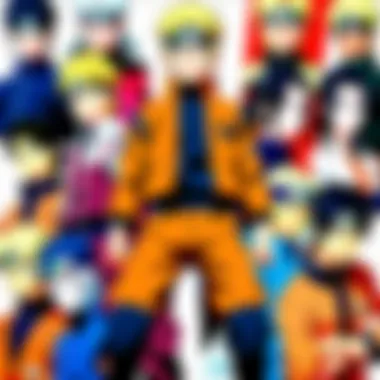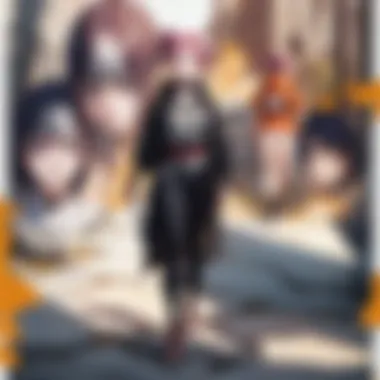A Complete Viewing Guide to Naruto Shippuden


Intro
Navigating the extensive world of Naruto Shippuden can feel like finding your way through a maze. This beloved anime series, a sequel to the original Naruto, picks up where the story left off, diving deeper into themes of friendship, sacrifice, and the perpetual struggle for peace. The narrative unfolds through a series of arcs that weave together intricate plots and character developments, making it essential to watch them in the intended order to fully appreciate the depth of the story.
By following this guide, both newcomers and devoted fans can immerse themselves in the tale of Naruto Uzumaki and his companions. From critical plot twists to emotional moments that tug at the heartstrings, understanding the viewing sequence enriches the experience. Let's embark on this journey, diving into the featured series and the characters that inhabit it.
Understanding Naruto Shippuden
Understanding Naruto Shippuden is crucial for anyone looking to get the most out of this landmark anime series. This sequel to the original Naruto series broadens the narrative scope while deepening character arcs, immersing viewers in a world rich with themes of friendship, conflict, and personal growth. Grasping the essence of Shippuden requires some familiarity with its predecessor, yet this guide aims to bridge these narratives so that both newcomers and veteran fans can appreciate the complex layers that unfold.
Overview of Naruto Shippuden
Naruto Shippuden picks up the story two and a half years after the end of the original series. Naruto Uzumaki, now a more mature ninja, returns to his village, ready to confront new challenges and formidable foes. This sequel series delves deeper into the lives of other characters, providing viewers with a more global perspective. As the plot thickens, the stakes are raised, leading to epic battles and emotional moments that can resonate with just about anyone.
The series intertwines various arcs that are essential for understanding the deeper dynamics at play. Each arc not only advances the story but also explores emotional and psychological growth of the characters, enriching the entire viewing experience. By keeping the settings and conflicts fresh, Shippuden holds audience attention while building on the lore established in the original Naruto.
The Evolution from Naruto to Shippuden
Transitioning from Naruto to Shippuden is akin to moving from a childhood playground to the more serious world of adolescence. The themes become heavier, and the storytelling matures alongside its characters. Naruto focuses largely on youth, friendship, and coming of age, while Shippuden confronts themes of loss, sacrifice, and the moral gray areas that often accompany conflict. The characters, especially Naruto and Sasuke, evolve significantly through their struggles, shedding light on complex issues that resonate with many viewers.
This evolution is marked by character development that feels genuine and earned; it reflects not just changes in age, but transformations shaped by their experiences. The intricate relationships, especially those fraught with tension like that of Naruto and Sasuke, add layers to the narrative that rewards close attention.
Significance of Watching in Order
When it comes to Naruto Shippuden, watching in chronological order is vital for fully appreciating the depth of its storytelling. Each episode builds upon previous events, and watching them out of sequence can leave significant gaps in understanding plot points and character motivations.
"Watching Shippuden out of order is like reading a book with missing chapters; the narrative just doesn't flow."
Furthermore, many fans express that the emotional weight of pivotal moments is experienced differently when one has followed the arcs chronologically.
- By starting with a recap of the original Naruto series, viewers establish the necessary foundation.
- Each arc in Shippuden unfolds logically, with cliffhangers that demand satisfaction in sequence.
- The interwoven narratives highlight not just personal growth but also the overarching themes that culminate in the later arcs.
In closing, understanding Naruto Shippuden is an essential step for enjoying the series. It opens the door to exploring critical themes, character dynamics, and narrative evolution while providing a roadmap that guides both new and old fans through the intricate web of stories that define this beloved anime.
Chronological Order of Naruto Shippuden
Watching Naruto Shippuden in chronological order is essential for new viewers and returning fans alike. The series is rich with character evolution, plot twists, and thematic depth that emerge from how events unfold. By following the storyline sequentially, viewers gain a comprehensive perspective on character motivations and relationships. Each episode builds upon the last, delivering a narrative that’s both cohesive and engaging.
One important aspect is the understanding of how characters have matured and changed since the original Naruto. This helps in grasping the weight of their actions and decisions in Shippuden. The rearrangement of episodes can also affect the emotional impact of certain arcs, as context is created through earlier events.
Another consideration when watching is that many filler episodes can disrupt the flow of the main plot. Although these fillers provide some fun and additional character interactions, knowing when to skip them or when they might provide some context is crucial. The goal is to navigate the series without losing sight of the evolving themes of friendship, sacrifice, and redemption that are pivotal to the Naruto franchise.


Starting Point: Naruto Series Recap
Before diving into Shippuden, it's wise to recap the original Naruto series. This recap helps to set the stage for the new adventures that follow. The original series introduces us to Naruto Uzumaki and his journey to becoming a Hokage while battling personal demons and evolving relationships with his friends. Important events, like Naruto’s early interactions with Sasuke and Sakura, and the significance of the Akatsuki organization, are foundational and will have lasting effects in Shippuden.
Recapping these critical elements not only clarifies why certain characters return with different dynamics but also enhances the viewing experience. For instance, the rivalry between Naruto and Sasuke evolves significantly and becomes a focal point of Shippuden.
Episode Breakdown of Naruto Shippuden
Main Arcs Overview
Main Arcs Overview provides a broad sketch of the storylines that define Naruto Shippuden. Each arc serves as a stepping stone in the narrative, focusing on specific conflicts and character developments. The arcs are notable for their depth, exploring themes like loss, perseverance, and the struggles faced by shinobi.
One of the key characteristics of the main arcs is their pacing. Shippuden often intertwines serious plot development with intense emotional stakes. For example, the Pain arc is particularly acclaimed for how it tackles themes of pain and understanding. This arc hones in on Naruto's growth as a ninja and person, making it essential viewing.
The unique feature here is how each arc culminates in significant battles and character shows. While this adds excitement, it can also overwhelm if consumed too quickly. Thus, the narrative structure encourages viewers to absorb the character growth between each episode, making it a beneficial choice for understanding the overall plot progression.
Filler Episodes
Filler episodes in Naruto Shippuden might initially appear to lack depth, but they often serve a purpose in enriching the series. While these episodes do not directly contribute to the overarching plot, they can enhance the viewing experience by providing character backstories or lighter, comedic moments amidst the tension.
One of the key characteristics of these fillers is their focus on secondary characters -- moments that showcase their personalities and backstories can deepen the viewer’s understanding of the main narrative. Notably, while some might view them as time fillers, others find value in their exploration of individual character arcs.
Ultimately, the unique aspect of fillers is the chance they offer to flesh out supporting characters. So, while some viewers might choose to skip them, they can be beneficial for providing a fuller understanding of the universe that Masashi Kishimoto has created.
Important Canon Episodes
Focusing on important canon episodes within Shippuden is crucial for main storyline comprehension. These episodes drive the plot forward, revealing key plot points and character arcs that are pivotal to the overall narrative.
Each canon episode often ends with cliffhangers or revelations that relate directly to the series' core conflicts. Notably, the introduction of the Akatsuki's motives and actions during various arcs is a hallmark of these episodes, impacting both Naruto and his friends’ journeys significantly.
The unique feature of these episodes lies in their capacity to stir emotional and narrative tension. They challenge viewers to invest in character relationships, making the dramatic arcs much more impactful. Therefore, pinpointing these important episodes is a wise move for anyone looking to fully grasp the intricate web of stories within Naruto Shippuden.
Filler Arcs in Naruto Shippuden
Filler arcs serve a distinctive purpose within the Naruto Shippuden series. They provide viewers with unique stories that, while tangential to the main narrative, can enrich the overall viewing experience. At first glance, these fillers might seem like mere distractions from the core storyline, but they often offer valuable insights into character backstories or present stand-alone adventures that can be just as engaging. More than just a collection of odd episodes, these fillers might be seen as a chance for some fun in the often intense narrative of Naruto Shippuden.
Identifying Filler Content
To effectively navigate through Naruto Shippuden, it’s crucial to distinguish filler episodes from the main canon. Typically, filler episodes can be identified by your knowledge of the manga source material and their absence from it. Characteristically, fillers do not contribute to the main story arcs. An easy way to verify this is by referring to online resources, like Wikipedia, which provides episode lists that specify which ones are fillers. Here are some key points to keep in mind:
- Watch for Anime-Only Storylines: Filler arcs often create original narratives not found in Masashi Kishimoto's manga.
- Check Episode Counts: Many fillers are grouped together into specific arcs that can be noted, such as the Chûnin Exam or Invasion of Pain, indicating the beginning and end of these non-canon segments.
- Community Recommendations: Platforms like Reddit have dedicated threads where fans discuss the fillers, which can help new viewers decide what to watch.
Key Filler Arcs Explained


While filler arcs in Naruto Shippuden may be secondary, several key arcs significantly add depth to characters or the world. For instance:
- The Twelve Guardian Ninja Arc: Here, the tale revolves around a group of elite shinobi tasked with protecting the Land of the Fire’s ruler. This arc sheds light on the concept of duty and protection, showcasing themes like honor and sacrifice.
- The Three-Tails Arrival Arc: This arc explores the danger posed by the Three-Tails, providing context for the jinchūriki notion and the vulnerabilities instilled in the various characters.
- The Konoha History Arc: A particularly interesting segment, it delves into the past of key Konoha figures, offering a greater appreciation for their motivations and personal journeys.
These arcs, while not directly impacting the main plot, provide enriching content that broadens the viewer's understanding of various characters’ minds and motives.
Impact of Filler on Main Narrative
The impact of fillers on the overarching narrative of Naruto Shippuden is complex. On one hand, they do divert attention from the main story arcs, potentially leading to frustration for viewers wanting to keep tight focus on significant plot developments. But on the other hand, fillers can act as a palate cleanser, relieving some tension present in intense arcs.
- Character Development: Certain filler content can flesh out supporting characters, granting them moments to shine. For instance, smaller characters like Anko and TenTen experience growth which might not be otherwise realized within the main arcs.
- Exploration of Themes: Fillers often reinforce the series' core themes, from friendship to conflict resolution, allowing viewers to see these concepts from different angles.
- Pacing: They can affect the pacing of the series, providing a break that might enhance the emotional weight of critical scenes when the primary story resumes.
Character Development Across Arcs
Character development is a pivotal aspect of storytelling, and in the realm of anime, Naruto Shippuden stands out as a prime example of how characters evolve through their journey. Each arc not only advances the plot but also offers a unique lens into the lives and growth of both main and supporting characters. Understanding this development allows viewers to appreciate the intricacies of relationships, motivations, and the overall narrative.
Main Character Arcs
The central figures in Naruto Shippuden undergo significant transformations. Notably, Naruto Uzumaki’s journey from a lonely outcast to a respected leader embodies the struggles of overcoming personal demons. His determination and unwavering spirit resonate with many fans, as he learns the value of teamwork and friendship, which shapes his identity.
Another compelling arc is that of Sasuke Uchiha. Initially driven by revenge, Sasuke’s path is marked by betrayal, conflict, and ultimately, redemption. His internal battle between loyalty to his friends and the desire for power is captivating, shedding light on the complexities of human emotions.
Equally important is Sakura Haruno, who evolves from a somewhat naïve and infatuated young girl into a powerful ninja in her own right. Her development challenges stereotypes often found in anime, showing that strength is not merely physical but also encompasses emotional resilience.
"Character growth in Naruto Shippuden is not just about becoming stronger; it’s about understanding oneself and others."
Supporting Character Focus
Supporting characters in Naruto Shippuden offer rich narratives that enhance the main plot. Characters like Kakashi Hatake and Gaara provide depth by exploring diverse themes such as loss and redemption. Kakashi's mysterious past as a former team leader and Shinobi gives viewers a look into the burdens carried by those in leadership, making him relatable.
Gaara’s transformation from a feared antagonist to a beloved ally presents a powerful narrative of change. His struggles with loneliness and his eventual acceptance into the community echo the series’ overarching theme of friendship and acceptance.
Moreover, minor interactions with characters like Tsunade and Jiraiya, add layers to Naruto’s character, emphasizing the importance of mentorship and the impact of familial relationships.
Antagonistic Forces and Their Evolution
The antagonists in Naruto Shippuden are not merely villains but rather complex characters driven by their own narratives. Figures like Orochimaru and Pain have layered motivations, challenging the perception of evil. Orochimaru's quest for immortality underscores themes of ambition gone awry, while Pain’s ideology invites discussions on pain, suffering, and the lengths to which one will go for peace.
As the series progresses, characters like Obito Uchiha reveal profound backstories that shift them from antagonists to sympathetic figures. These evolutions enrich the narrative, compelling viewers to ponder deeper philosophical questions about right and wrong.
Through these character arcs, Naruto Shippuden crafts a multifaceted narrative that drives home the importance of growth, relationships, and the human experience. This depth is precisely what makes the series not just a story about ninjas but a chronicle of life’s complexities.


Themes and Philosophies in Naruto Shippuden
In any narrative, themes serve as the backbone, guiding the viewer’s experience and deeper understanding. Naruto Shippuden explores a myriad of philosophies that resonate not just with the series' characters but also with audiences at large. This section unpacks three prominent themes: friendship and loyalty, conflict and resolution, and legacy and growth. Each theme intertwines intricately, shaping the characters and the plot in ways that maintain viewer engagement and emotional investment.
Friendship and Loyalty
At the heart of Naruto Shippuden is the undeniable bond of friendship and loyalty, exemplified through the relationships between the characters. Naruto, with his unwavering commitment to his friends, often finds himself at a crossroads where these values are put to the test. The numerous instances where he fights not just for his own ambitions but for the protection of his comrades underline a core message: friendship can be a formidable source of strength.
For instance, Naruto’s relationship with Sasuke is layered with rivalry and affection. Their connection exemplifies how loyalty can pave the way for redemption. Sasuke's journey strays from the path of friendship, pushing Naruto to take a stand and protect what he believes in. This dynamic illustrates how friendship isn't merely about camaraderie; it also involves facing one's inner demons alongside another.
"In this series, friendship often triumphs over adversity, showing that together we can weather any storm."
Conflict and Resolution
Conflict in Naruto Shippuden serves as a catalyst for character evolution and thematic exploration. Life in the ninja world is filled with battles—both physical and emotional. Naruto encounters several conflicts: personal battles against his own past, external skirmishes with various antagonists, and the ideological rifts among his peers.
The series meticulously navigates these conflicts, showing that resolution comes not through violence alone but through understanding and communication. A pivotal moment is Naruto’s confrontation with Pain, where he emphasizes that continuing cycles of hatred and revenge lead nowhere. This confrontation encapsulates the essence of the series’ profound message about breaking the cycle of conflict through compassion and dialogue.
Legacy and Growth
Legacy and growth instantaneously echo through the lives of characters in Naruto Shippuden. The concept of legacy isn’t just about what one leaves behind but also about personal development and the influence of mentors. Characters such as Kakashi and Jiraiya embody the notion that the training and values passed down from one generation to the next play an integral role in shaping future heroes.
The growth of Naruto from a ostracized boy to the hero of the Hidden Leaf Village not only touches personal achievement but also speaks to a larger narrative. His journey symbolizes that the struggles faced can become stepping stones for future leaders. As he rises to become Hokage, he connects past scars to future healing, demonstrating that true legacy is built on the foundations of lessons learned through hardship.
These overarching themes serve as a mirror reflecting human experiences. They resonate deeply, bridging gaps between the fictional ninja world and real-life struggles, thus inviting viewers to contemplate their own lives as they journey through the intricate layers of Naruto Shippuden. By engaging with these themes, audiences can appreciate not just the narrative but the wisdom embedded within it.
Finale and Recommendations
As we wrap up this comprehensive guide to watching Naruto Shippuden, it’s essential to highlight the significance of understanding how to navigate the series effectively. This part of the journey is not just about watching an anime; it’s about immersing oneself in a richly woven narrative that explores the depths of friendship, loyalty, and personal growth. Recognizing the intended sequence of episodes allows viewers to grasp the intricate character developments and overarching themes present throughout the series.
Final Thoughts on the Viewing Experience
In contemplating your viewing experience, remember that Naruto Shippuden transcends mere entertainment. It stands as a mirror reflecting the complexities of life itself. Each arc, whether it contains pivotal plot advancements or even filler content, carries lessons and philosophies that resonate with real-world challenges. Embracing these narratives fully will enhance your overall experience while watching. By delving into the characters' journeys, one finds connections that may stir your own thoughts and emotions.
A unique blend of action, emotion, and moral dilemmas demands your attention, allowing you to see the transformation not only of Naruto but of all significant players within the story.
Suggestions for Further Exploration
If you find the world of Naruto captivating, consider exploring relative media that can complement your understanding. This might include manga series that reveal extra character backgrounds and side stories, or exploring fan translations and discussions that dive deep into lore details and theories. Here are a few suggestions:
- Related Manga: Check out "Naruto" to get the complete narrative arc, as well as spin-offs like "Boruto: Naruto Next Generations."
- Supplementary Materials: Look for art books and guides that delve into production notes and artistic choices, enriching your appreciation for the anime’s evolution.
- Community Engagement: Dive into forums and discussions on platforms like Reddit or Facebook where fans gather to share their impressions and analyses. These conversations can open new avenues of thought and perspective.
Engagement with the Naruto Community
Engaging with the Naruto community can profoundly enrich your viewing experience. The collective passion among fans often leads to eye-opening discussions about character motives or hidden details that you might overlook alone. Finding social connections through shared admiration for Naruto Shippuden can enhance your journey.
- Join Fan Groups: There are many Facebook groups and Reddit communities where you can discuss episodes or share fan art. Connecting with other fans promotes a lively exchange of ideas.
- Participate in Events: Look for conventions or online events centered around Naruto. Participating in discussions can kindle excitement and deepen your understanding.
- Engage in Perhaps Fan-Creative Works: Whether it’s creating fanfiction, art, or even cosplay, contributing creatively can add another dimension to your experience.
In summary, watching Naruto Shippuden is but the first step in an extensive world rich with interpretations, emotions, and community connections. By following the viewing order outlined and actively engaging with the community, viewers will find not only a story to watch but a world to belong to.



